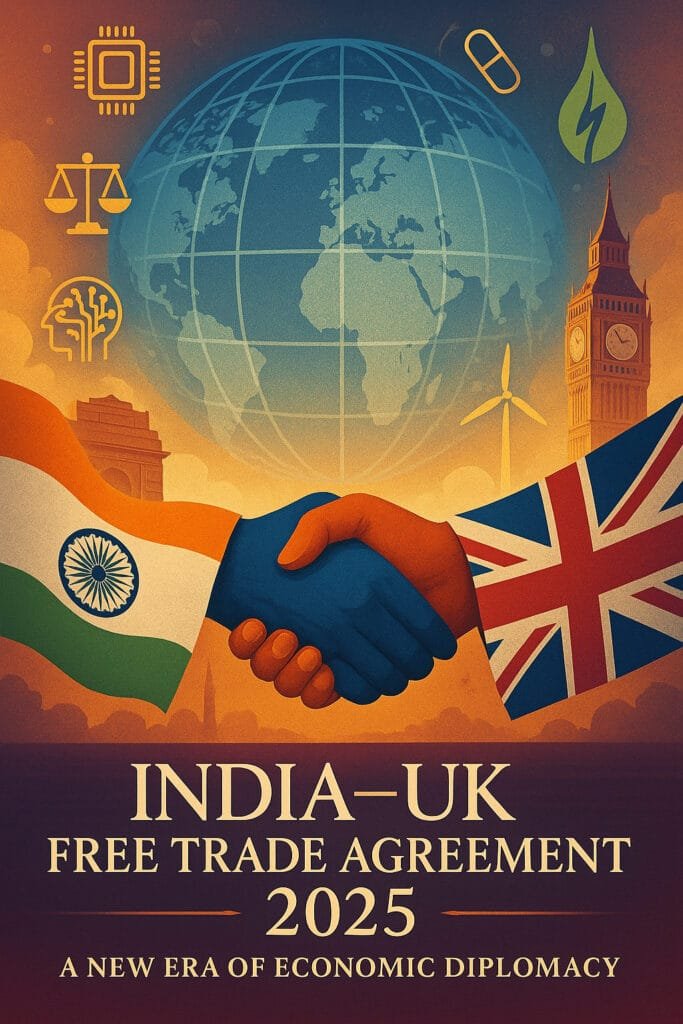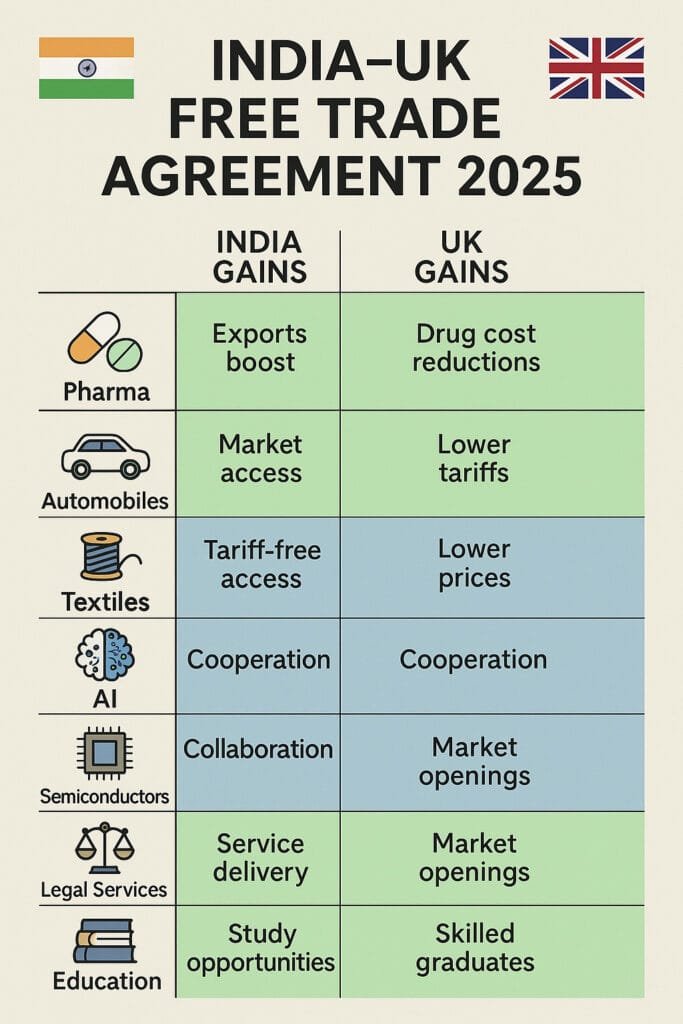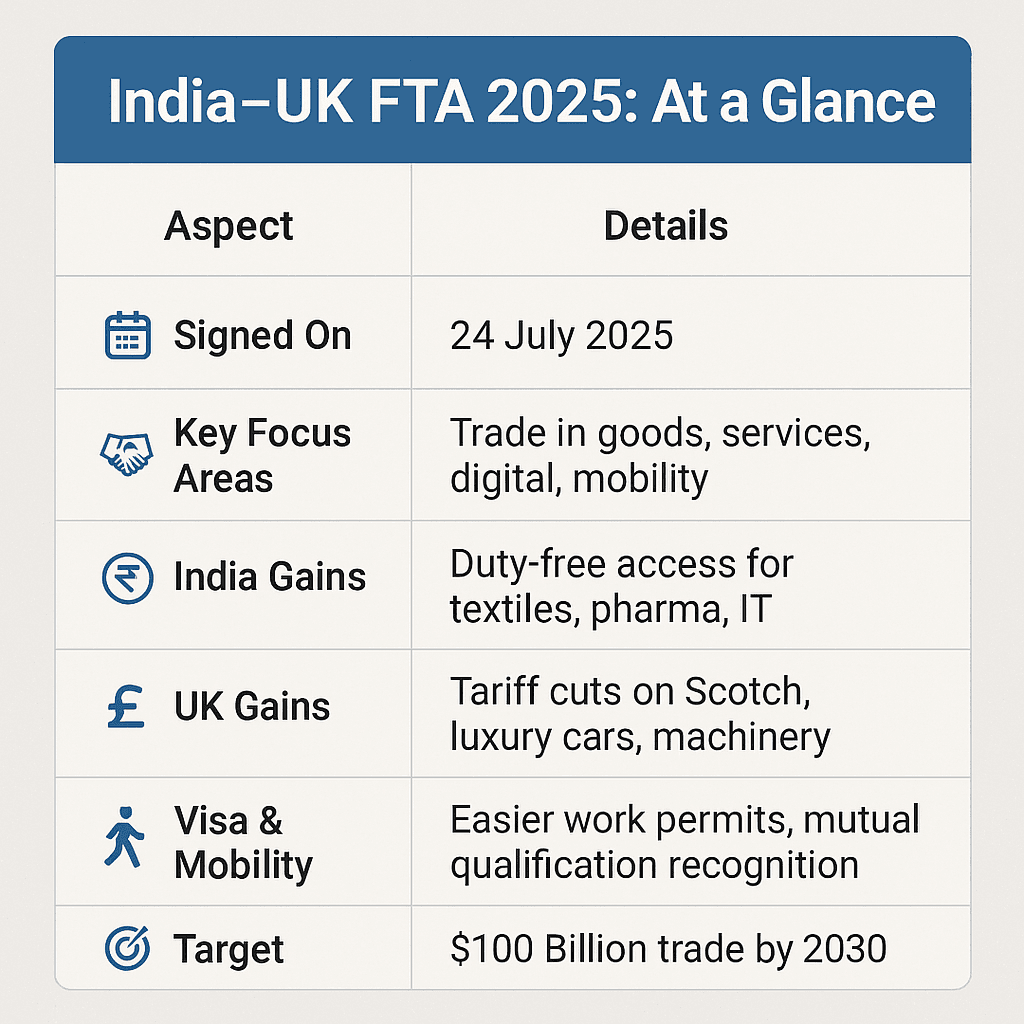On July 24, 2025, a major chapter in international trade relations was written as Indian Prime Minister Narendra Modi and UK Prime Minister Keir Starmer signed the long-awaited India–UK Free Trade Agreement (FTA) at Chequers. The deal was celebrated by both leaders as a historic breakthrough—Starmer calling it a “landmark moment” and a “major win for Britain,” while Modi described it as a “blueprint for our shared prosperity.”
This agreement, formally known as the Comprehensive Economic and Trade Agreement (CETA), is the most significant FTA India has concluded with a major developed economy in over a decade. For the UK, it stands as the most ambitious bilateral trade pact since Brexit. It is expected to give a robust push to bilateral commerce, with both sides projecting a dramatic increase in trade volumes—estimated to rise by approximately £25.5 billion (US$34 billion) annually by 2040. The two countries aim to nearly double their total trade, reaching an estimated $120 billion by 2030.
The FTA focuses on sweeping tariff reductions across sectors and sets the stage for broader collaboration in services, investment, and the mobility of professionals. Nearly 99% of Indian exports to the UK and around 90% of UK exports to India will now enjoy duty-free access. Some of the most eye-catching gains include immediate halving of UK tariffs on key imports like Scotch whisky and cars, and the complete elimination of tariffs on Indian exports such as textiles, apparel, leather goods, and footwear.

Beyond just goods, the agreement also covers a forward-looking agenda: simplifying business travel, strengthening regulatory cooperation, and embedding shared commitments to gender equality, environmental sustainability, and fair labor practices.
Major Terms and Tariff Reductions
At the heart of the India–UK FTA is comprehensive tariff liberalization. Both nations have committed to slashing or phasing out duties on the majority of traded goods under well-defined schedules.
Under the terms of the agreement, the UK will reduce or eliminate tariffs on 90% of its tariff lines, which account for nearly 92% of India’s current exports to the UK. This reduction will be implemented progressively over a ten-year period.
Some of the most immediate changes include:
- Scotch whisky and gin tariffs will drop from 150% to 75% right away, and further reduce to 40% over the next decade.
- Brandy and rum will see a phased reduction from current levels to 110%, and eventually to 75%.
- British car manufacturers will benefit from a quota-based system allowing tariffs on vehicles to be cut from 110% down to just 10% within five years. Indian and other global automakers will also be allowed to ship a growing volume of cars into the UK duty-free.
- Luxury cars such as Jaguars, Land Rovers, and Aston Martins will enjoy improved market access in India, with relaxed duties or quota-based exemptions.
For Indian exports, the gains are even more striking.
Nearly 99% of Indian tariff lines will receive zero-duty access to the UK market immediately, unlocking between $23 billion to $34 billion in new export opportunities. This benefits a wide array of sectors:
- Textiles and garments: Over 1,100 product lines—previously facing 10–12% tariffs—will now enter the UK duty-free.
- Footwear and leather goods: Exporters in these labour-intensive sectors gain full duty-free access, significantly improving their competitiveness.
- Jewellery, handicrafts, and engineering goods: Duty elimination opens the door to stronger market penetration.
- Pharmaceuticals and electronics: Indian manufacturers will benefit from reduced costs and faster market entry.
- Agricultural and processed food items: Products like spices, tea, coffee, mango pulp, and pickles will see steep duty cuts.
Importantly, sensitive agricultural categories—such as dairy, edible oils, apples, and oats—have been placed on a protective list and will not see tariff reductions. However, Indian farmers will benefit substantially, with about 95% of farm-related exports gaining duty-free access to the UK, including high-value crops like basmati rice and tropical fruits. Additionally, 99% of Indian seafood—including popular varieties like shrimp and tuna—will now be exported to the UK without any tariffs.
For the UK, the benefits are equally significant. The average tariff faced by British goods entering India will fall from approximately 15% to just 3%. Already, UK exports to India include a wide range of goods—spirits, cosmetics, beverages, aerospace components, and automotive parts—all of which will now benefit from reduced trade barriers. Projections suggest that British exports to India could grow by as much as 60%, contributing an estimated £15.7 billion in additional trade value by 2040.
On the import side, India’s tariff reduction makes UK products more competitive and affordable in the Indian market. At the same time, British consumers stand to benefit from a broader and more affordable range of Indian products. With UK tariffs on Indian goods dropping from 15% to around 3%, imports are expected to rise by about 25%, adding approximately £9.8 billion in new trade flows by 2040.
Additional Trade Facilitation and Institutional Frameworks
Beyond tariff cuts, the FTA introduces a range of measures designed to streamline trade and enhance mutual trust between regulators and businesses.
- Customs processing will be expedited, with a commitment to clear compliant goods within 48 hours.
- Regulatory hurdles are to be reduced through increased transparency and harmonized standards, particularly in digital trade and services.
- Digital trade commitments will allow businesses to operate more efficiently across borders with simplified documentation and data transfer protocols.
Notably, this agreement covers several new areas rarely included in India’s past trade deals:
- Labor and gender standards: Shared benchmarks are set to encourage fair practices and greater gender inclusivity in trade participation.
- Anti-corruption provisions and disciplines on state-owned enterprises are aimed at ensuring fair competition.
- A Double Contributions Convention was also signed alongside the FTA. This ensures that professionals and workers from either country will need to pay social security contributions in only one jurisdiction, not both—an important relief for expatriates and businesses managing overseas employees.
- A roadmap for a future bilateral investment treaty (BIT) has also been agreed upon, signalling intent for deeper investment collaboration in the years ahead.

Sectoral Impacts and Benefits
The India–UK Free Trade Agreement unlocks significant opportunities across multiple industries, particularly for India’s labour-intensive sectors. With tariffs eliminated, industries like textiles, garments, footwear, leather, and jewellery — which employ millions — are expected to see sharp growth. In Tirupur, knitwear exporters anticipate a 60% rise in UK sales, while industrial hubs like Surat, Ludhiana, and Agra are preparing for expansion.
Agricultural exports are set to benefit as well. Basmati rice, spices, tea, turmeric, cardamom, and millets will now enter the UK duty-free, potentially boosting Agri-exports by 20%. Processed products like spice mixes, pickles, and ready-to-eat meals will also become more competitive. The seafood sector scores major gains too, with 99% of shrimp and tuna exports now duty-free.
Cultural and regional exports will gain visibility through recognition of Indian Geographical Indication (GI) products such as Goan feni, Kerala toddy, and Nashik wine. Additionally, sectors like engineering goods, pharmaceuticals, electronics, and chemicals will enjoy improved market access. Officials expect this to translate into wider product variety and lower prices for Indian consumers.
In services, India retains its preferential status in IT, finance, education, and engineering. New visa arrangements will ease movement for professionals, with exemptions from UK social security contributions and 1,800 temporary work slots for chefs, yoga instructors, and musicians. These steps are set to strengthen India’s global service exports.
For the UK, the FTA opens the doors to India’s massive market. British whisky and beer producers are key beneficiaries, with tariffs on Scotch whisky halving immediately and dropping further over time. UK cars — including Jaguar, Mini, and Land Rover — will face sharply reduced duties, making them more accessible to Indian buyers.
Indian demand for UK-made products like aerospace equipment, clean energy tech, and financial services is expected to grow. British exporters in machinery, cosmetics, processed foods, and dairy alternatives will also gain a foothold. UK consumers, in turn, will see lower prices on Indian goods like jewellery, tea, and garments.
Political Reactions and Leadership Statements
Leaders from both countries praised the agreement as a transformative milestone. Prime Minister Modi described it as a “blueprint for shared prosperity,” highlighting its potential to boost sectors like textiles, jewellery, and seafood. British Prime Minister Keir Starmer called it the most important trade deal for the UK since Brexit, forecasting job creation and increased exports.
“This Agreement is not just an economic agreement but also the plan for a shared prosperity.”
Prime Minister Narendra Modi
India’s Commerce Minister Piyush Goyal underlined that 99% of Indian exports now receive duty-free access, opening $23 billion in opportunities — especially for MSMEs, women entrepreneurs, and farmers. He noted the waiver of UK social security contributions and expanded visa provisions as key win for Indian professionals.
“This is the biggest and most economically significant trade deal the UK has made since leaving the EU.”
UK Prime Minister Keir Starmer
UK business leaders welcomed the deal as a positive signal for global trade. Organizations like the Confederation of British Industry and British Chambers of Commerce emphasized its potential to boost sectors such as aerospace, finance, and creative industries.
While overall reactions were positive, some concerns were raised. UK auto groups worried about increased competition from Indian carmakers, and labor organizations questioned the impact of expanded visa access on local employment. Others noted that while the projected £4.8 billion GDP boost is welcome, it is modest relative to the UK’s economy.
“Our landmark trade deal with India is a major win for Britain. It will create thousands of British jobs … unlock new opportunities for businesses … and drive growth in every corner of the country.”
Jonathan Reynolds, UK Business & Trade Secretary
Despite these reservations, the agreement was widely celebrated as a symbol of deeper cooperation. Media and business leaders in both countries recognized it not only as an economic win, but also as a sign of renewed trust between two historic partners.
Historical Context: From Colonial Ties to Trade Pact
The India–UK Free Trade Agreement didn’t happen overnight. While both countries share a long and complex history—from colonial trade to post-independence cooperation—formal negotiations for an FTA are relatively recent.
Talks began in January 2022, after an initial partnership was announced in 2021. Despite ambitious goals to finish by Diwali 2022, political changes in the UK and election cycles in India caused delays. Over 15 negotiation rounds were held between 2022 and 2024, with final hurdles around visas, national insurance, and climate-related taxes. Eventually, compromises were made, including a separate social security agreement.
The deal was finalized under UK Prime Minister Keir Starmer and Indian Prime Minister Narendra Modi. It was agreed in principle in May 2025 and officially signed in July at Chequers, marking a major milestone in bilateral relations.
This agreement also reflects a shift in both countries’ trade strategies. For the UK, it’s one of the most significant trade deals since Brexit. For India, it joins a growing list of recent FTAs—including with the UAE and Australia—that open up markets, reduce tariffs, and promote services and mobility. The UK deal stands out for its wide coverage: not just goods, but also digital trade, professional mobility, and legal protections like GI tags.

Geopolitical and Economic Implications
Strategically, the FTA strengthens India’s ties with a major Western economy and signals its growing readiness to engage with developed markets. It also helps India diversify trade beyond traditional partners like China and the Gulf. With Britain among India’s top 12 trade partners, the agreement could boost India’s global influence.
The UK, meanwhile, sees this as a key part of its post-Brexit “Global Britain” vision. It opens access to one of the world’s fastest-growing economies and helps make up for reduced EU trade. British leaders also see the pact as proof they can strike ambitious deals independently. Economically, the agreement is expected to support jobs across sectors—from engineering and IT to hospitality—while strengthening long-term cooperation.
On a global level, the deal reflects a broader shift: countries like India and the UK are turning to trusted bilateral partnerships amid global trade uncertainty. While India remains cautious about joining large trade blocs, deals like this improve its leverage in future negotiations. For the UK, the agreement sends a clear message that it remains open for business despite leaving the EU.
Comparison with Other Deals
Compared to India’s recent FTAs, this one is broader and more strategic. The UAE agreement eliminated nearly all tariffs and included strong services elements. The Australia deal focused on key exports like coal, lentils, and minerals. But the UK pact goes further—covering high-value areas like luxury goods, automobiles, textiles, IT services, digital trade, and mobility.
This deal is also politically significant. The UK is a former colonial power and one of the world’s largest economies, making this more than just an economic arrangement—it’s a historic realignment. Both governments have described it as one of their most comprehensive and ambitious trade deals to date.
Recent FTAs show India’s move toward deeper trade integration with high-income economies. While still avoiding large regional blocs, India is clearly shifting toward mutually beneficial bilateral partnerships with global impact.
Conclusion
The India–UK Free Trade Agreement signed on July 24, 2025, represents more than just tariff reductions or economic exchange—it marks a strategic reset in a historic relationship. With key sectors like Scotch whisky, automobiles, textiles, tea, and information services seeing expanded access and reduced duties, both nations stand to benefit from new opportunities in trade, investment, and innovation.
For India, it strengthens its vision of becoming a global manufacturing and services hub, especially boosting MSMEs and labour-intensive exports. For the UK, it offers a much-needed post-Brexit anchor in the Indo-Pacific, diversifying its trade partners and solidifying diplomatic goodwill.
While some debates remain around domestic sector protections and timelines, the FTA is being widely seen as balanced and forward-thinking. It carries the potential to nearly double bilateral trade in a decade, generate jobs, ease professional mobility, and deepen regulatory alignment.
In essence, the India–UK FTA is not just an economic deal—it’s a milestone in trust-building and global partnership between two democracies seeking growth through cooperation, not competition. As the world shifts toward a multipolar trade order, this pact could very well become a model for future FTAs.
Stay informed. Stay ahead.
📢 Share this article with your network
🌐 More insights await at thinkingthorough.com
💡 Let’s connect on social—your thoughts matter to us.
References
Impact assessment of the Free Trade Agreement between the UK and India executive summary (web version). (2025, July 24). GOV.UK. https://www.gov.uk/government/publications/uk-india-free-trade-agreement-impact-assessment/impact-assessment-of-the-free-trade-agreement-between-the-uk-and-india-executive-summary-web version#:~:text=trade%20with%20India%20,Owned%20Enterprises%20%28SOEs
Jazeera, A. (2025, July 24). UK and India sign free trade agreement during Modi visit. Al Jazeera. https://www.aljazeera.com/news/2025/7/24/uk-and-india-sign-free-trade-agreement-during-modi-visit#:~:text=British%20Prime%20Minister%20Keir%20Starmer,Goyal%2C%20formally%20signed%20the%20agreement
Mishra, R. D. (2025, July 25). UK trade deal: India gains big in food, footwear, textile; to cut tariffs in auto, liquor. The Indian Express. https://indianexpress.com/article/explained/explained-economics/uk-trade-deal-india-gains-big-in-food-footwear-textile-to-cut-tariffs-in-auto-liquor-10147947/
Online, E. (2025a, July 24). India-UK FTA: PM Modi, Starmer to sign historic deal, $34 bn annual trade boost ahead. The Economic Times. https://economictimes.indiatimes.com/news/economy/foreign-trade/india-uk-fta-pm-modi-starmer-to-sign-historic-deal-34-bn-annual-trade-boost-ahead/articleshow/122872196.cms?from=mdr Online, E. (2025b, July 25). Stitching a comeback: India’s textile trade finds new threads in UK deal. The Economic Times. https://economictimes.indiatimes.com/industry/cons-products/garments-/-textiles/india-uk-fta-textile-exports-duty-free-access-trade-opportunity/articleshow/122904079.cms?from=mdr
Frequently Asked Questions (FAQs) about India UK Trade agreements
What does India import from the UK?
India imports a range of products from the UK, with key categories including pearls, precious stones, metals (like silver), machinery, electrical and electronic equipment, iron and steel, and optical/medical apparatus. Following the new FTA, luxury goods such as British automobiles and whisky are expected to become cheaper in India due to reduced tariffs.
What is most exported from India to the UK?
India's top exports to the UK include electrical and electronic equipment, machinery, mineral fuels and oils, pearls, precious stones, metals, and pharmaceutical products. Labour-intensive sectors like textiles, leather goods, and agricultural products are also significant exports and are expected to see increased demand due to duty-free access under the new FTA.
What is the UK's biggest export to India?
The UK's biggest export to India, in terms of value, is typically pearls, precious stones, and metals. Other significant exports include machinery, electrical and electronic equipment, iron and steel, and aluminum. The FTA is expected to particularly boost exports of British whisky and cars to India.
Who is India's largest trading partner?
India's largest overall trading partner is the United States. However, China is India's largest import partner, while the United States is India's largest export partner.
Who is the UK's largest export partner?
The United States is the UK's largest export partner.
